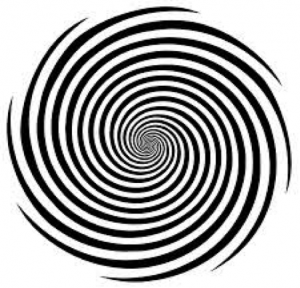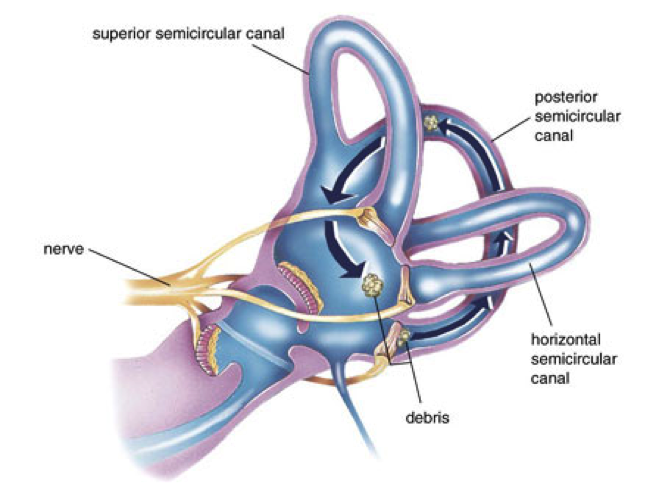BPPV (Benign Paroxysmal Positional Vertigo): What Is It & How do you Fix It?
Written by Physio Helen Sibbald
Have you experienced vertigo or know someone who has? If so, you/they may have/have had BPPV (Benign Paroxysmal Positional Vertigo).
BPPV is caused by the mechanical displacement of calcium carbonate crystals in the semicircular canals of the ear. Simply put – it is an ear problem! It is an extremely common vestibular disorder. 50% of people over age of 65 with dizziness were diagnosed with BPPV. It is more common in adults and women.
The experience of BPPV can be devastating, frightening, and debilitating. Vertigo is a spinning, out of control feeling, very unpleasant. However, this is one of the easiest vestibular dysfunctions to identify and treat effectively. There is usually an 80-90% success rate with only 1 treatment. Occasionally 2 treatments may be necessary.
What is BPPV?
You would experience brief episodes of vertigo (spinning/turning) brought on by positional changes of the head with respect to gravity. Vertigo is a specific perception of body motion – so spinning or turning. In the acute phase of BPPV, this feeling of body motion may also be accompanied by nausea, vomiting, and sweating.
You may ask, “ I feel dizzy sometimes, do I have BPPV? Well, dizziness (as apposed to vertigo) is a more non-specific term – woozy, lightheaded, giddy, feeling off – whereas vertigo is a more specific feeling of body motion. The vertigo of BPPV is severe and only happens when you change your head position in relation to gravity for example, when you look up to a high shelf (BPPV is sometimes referred to as “top shelf vertigo”); when rolling over in bed; getting out of bed; lying down to one side or the other; washing hair, at dentist or the hairdressers; looking down….You would soon learn what provokes your vertigo and start avoiding that movement. However, if you experience moderate dizziness all the time (ie: not brought on by head position change), have a tendency to fall, have weakness in arms and/legs, you may have a more serious problem requiring medical attention.
Other symptoms BPPV sufferers complain of are: poor balance; trouble walking; lightheadedness; nausea; feeling queasy; spinning inside the head; a sense of tilt; sweating; a sense of floating; blurred vision; jumping vision.
What causes BPPV?
If you are under the age of 50, then direct head injury or indirect for example a whiplash injury can cause BPPV. Over the age of 50, it could be degenerative, or an ear infection could be the cause.
What is actually happening in my ear?
We have calcium carbonate crystals in the utricle of our inner ear. The utricle may have been damaged by head injury, infection, or other disorders of the inner ear, or may have degenerated because of advanced age. A crystal then becomes dislodged and moves into the fluid in the semicircular canals of our inner ear, causing vertigo.
How would the diagnosis of BPPV be made?
Your Dr or Physio trained in assessing and managing BPPV, would do some tests: one is a test called the Dix-Hallpike test.
During this test you would be gently moved from a sitting to a lying position, with your head in a certain position. This will bring on the vertigo and the tester will be watching your eyes for nystagmus (a non voluntary rhythmic oscillation of the eyes). If you cannot tolerate this position, a gentler, side-lying test can be performed.
Helen also uses Vesticam Infrared Googles to ensure accurate diagnosis of your eye nystagmus
How would BPPV be treated?
Treatment is a simple repositioning manouevre to move the crystal through the canals back to the utricle , where they dissolve. The choice of treatment is determined by the ear canal affected and the type of BPPV, and the practitioner will watch your reaction to the test and then perform the appropriate movements on you to reposition the crystal. These movements are similar to the test, so don’t be nervous!
Home advice and exercises would be given to you to manage the condition over the next couple of days.
Recurrences do occasionally occur, you would then recognize it, not be so afraid, and perform the exercise you have been shown. In a large percentage of cases, problem resolves, if not, come in for one treatment and we would do the same repositioning manouevre.
Conclusion: BPPV can be a frightening disorder for you, the patient, but it can easily be tested for and treated!



































